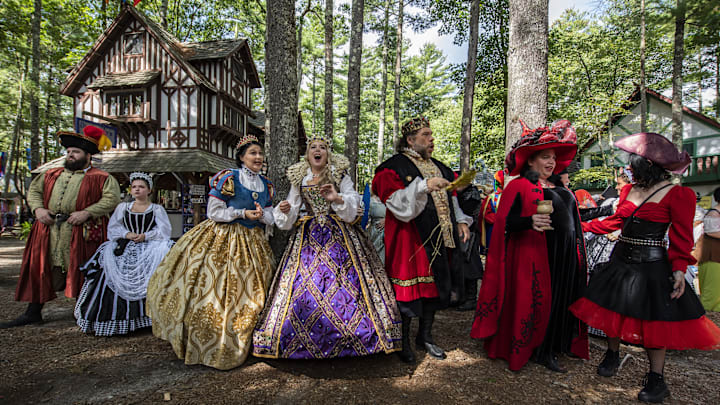Every year, people don their best historical attire and head to their local Renaissance fair to chomp down on a turkey leg and wish fellow attendees “good morrow.” There are hundreds of different Renaissance fairs that take place across the world. Each one is unique and unforgettable. But it can be a little bit intimidating to go to your first festival if you don’t know some basic Ren fair facts.
1. Renaissance fairs aren’t all based at the same time in history.

The Renaissance took place between the 14th and 17th centuries and was characterized by a huge period of growth for philosophy, literature, and art. Because it’s difficult to capture several hundred years in a single fair, many Renaissance fairs take place at different points in history. Some events are based during Henry VIII’s reign, while others may take place during the Elizabethan era or even the French Renaissance.
2. The first modern Renaissance fair was held in California in 1963.

Renaissance fairs tend to be popular events, which makes it easy to assume they’ve been around for a long time. But Ren fairs as we know them today are fairly modern: The first one took place in California in 1963. The concept for the Renaissance fair was originally intended to be educational, giving participants the chance to see “living exhibits.” Today, there are hundreds of Renaissance fairs around the world that provide a variety of different entertainment and educational opportunities.
3. The biggest Renaissance fair is held in Texas.
Renaissance fairs range in size and style. But the Texas Renaissance Festival usually takes the crown when it comes to having the biggest event. This fair has hosted as many as 500,000 people throughout the course of its season; many other large Ren fairs will get closer to 200,000.
4. Renaissance fair performers use some Early Modern English phrases.
When you step into your local Renaissance fair for the first time, you might be surprised to hear entertainers speaking in specific dialects and using particular phrases. A lot of Ren fair performers and participants speak in Elizabethan English (though it isn’t always entirely accurate). If you’ve had a bit too much mead and need to empty your bladder, try asking “whither be the privies?” instead of “where’s the bathroom?”
5. A lot of Renaissance fair attendees dress up.

In addition to speaking Early Modern English, many attendees dress up in Renaissance garb. As with the language, the clothes aren’t always true to the past; some people stick to historical accuracy, while others take creative liberties with their fashion (and some even go the fantasy route—don’t be surprised if you spot some fairies and elves in the crowd). Visitors will also choose costumes that align with various theme weekends and show up as pirates, Vikings, and more. It’s not a requirement to dress up, but Renaissance enthusiasts can often rent costumes on the premises to fully commit to the fair experience.
6. Turkey legs are a big part of the Renaissance fair experience.
Some Renaissance fair participants attend the events just for the sake of the turkey legs, but whether or not they would have actually been available in real life depends on which era a particular Renaissance fair is set in. Turkeys weren’t introduced to Europe until the 1500s, so the average person in Elizabethan England probably didn’t wander around noshing on one.
7. Renaissance fair demonstrations are often historically accurate.

Come for the turkey legs, stay for the demonstrations showcasing various artisan skills like blacksmithing or glass blowing. The food and costumes may not always stay true to history, but the demonstrations often do.
8. Renaissance fairs feature various forms of entertainment.

In addition to demonstrations, most Renaissance fairs feature a variety of different entertainment types. From Shakespearean plays to juggling, dancing, magic shows, and singing, there’s usually some type of spectacle at hand. These types of events tend to focus on fun rather than historical accuracy. On rare occasions, some Renaissance fairs have even been known to feature special guests like the author of Outlander (even though the series takes place after the Renaissance).
9. Jousting predates the Renaissance.
Most Ren fairs include jousting as a marquee event. Jousting, like other equestrian activities, has military roots. What began as a combat training exercise became a way for knights and nobles to show off their fighting prowess. The first recorded jousting tournament took place in 1066, and the sport remained popular throughout the medieval period. During the Renaissance, jousting became more about pomp and pageantry rather than combat, and it eventually fell out of fashion in the 17th century. The jousting featured at most Ren fairs is a much tamer version of the sport.
